Samsung Foundry expects that the Exynos 2600, Samsung’s new application processor (AP), will be the first chip manufactured by the foundry using its 2nm GAA process. 2nm chips are made with smaller features including transistors allowing more of them to fit inside a designated area. This transistor density reading is important because the higher it is, the more powerful and energy efficient these chips are.
Samsung is replacing FinFET transistors with Gate-All-Around
In addition, Samsung is replacing the now aging FinFET transistor, first introduced by Samsung with its 14nm mobile APs in 2015, with Gate-All-Around (GAA) transistors. These transistors use vertically placed horizontal nanosheets as gates that cover the channel on all four sides. This reduces any current leaks and improves the drive current resulting in more powerful chips with more energy efficiency.
Samsung’s Exynos 2600 AP delivers a 5% hike in performance. | Image credit-Samsung
If things go as planned, the iPhone 18 series won’t be the first smartphone to sport a 2nm chip as the iPhone was with the 7nm A12 Bionic AP (released in 2018 powering the iPhone XS and iPhone XS Max models), the 5nm A14 Bionic AP (released in 2020 with the iPhone 12 and iPhone 12 Pro Series), and the 3nm A17 Pro AP (released in 2023 inside the iPhone 15 Pro and iPhone 15 Pro Max).
Samsung expects its 2nm chips to feature a 5% performance hike compared to 3nm
So how much improvement is there between the 3nm Exynos 2500 and 2nm Exynos 2600? Previous estimates called for 2nm SoCs to generate:
- Up to 12 percent increased performance compared to 3nm.
- Up to 25 percent better power efficiency compared to 3nm.
- Up to 5 percent reduced area compared to 3nm.
- Up to 5 percent increased performance compared to 3nm.
- Up to 8 percent better power efficiency compared to 3nm.
- Up to 5 percent reduced area compared to 3nm.
Samsung Foundry’s all-important yield at 2nm has reportedly risen from a low 30% to a range in the 50%-60% area. That is important because it means that Samsung Foundry can now increase wafer production from the previous monthly output of only 15,000 units. As a result, Samsung Foundry should be able to supply enough Exynos 2600 APs for Samsung’s 2026 flagship line.
Last year, thanks to Samsung Foundry’s low 3nm yield, not enough Exynos 2500 chips could be made for the Galaxy S25 line. This forced Samsung to spend $400 million it didn’t originally budget to purchase Snapdragon 8 Elite APs for the Galaxy S25 and Galaxy S25+, both of which were expected to ship with the Exynos 2500 AP.
Are we seeing a sustainable turnaround for Samsung Foundry?
Samsung Foundry has inked deals with MicroBT and Canaan, two of the world’s biggest cryptocurrency mining equipment manufacturers, for 2nm GAA chips. The foundry also has a multibillion-dollar deal with Tesla. This is good news for Samsung Foundry as it had only 7.3% of the foundry market in the second quarter this year compared to TSMC’s leading 70.2% slice of the global foundry pie. Samsung Foundry is expected to turn profitable in 2027 at which time Samsung hopes to have its market share up to 20%.
This would represent a major turnaround for Samsung Foundry considering that it was just a few years ago when Qualcomm pulled the Snapdragon 8 Gen1 AP from Samsung, revised the specs, and had TSMC build the Snapdragon 8+ Gen 1. Since then, all Snapdragon chips have been manufactured by TSMC. Every year there is talk about Qualcomm switching back to Samsung Foundry, but so far this has not taken place despite the annual rumor.
Unlimited plans for $15/mo at Mint!
Mint Mobile is also offering an incredible bargain for those seeking unlimited data! The carrier’s latest deal lets you grab any unlimited plan for just $15/mo, bringing the 12-month Unlimited plan to $180 instead of $360.
Buy at Mint Mobile
Read the latest from Alan Friedman

